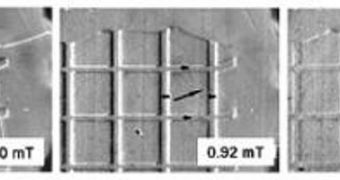Electromagnetic nanostructures used in data storage are, at this point, some of the most complex devices in the world, and they make storing information at the nanoscale possible with relative ease. But a tiny grid of the stuff has recently led researchers to a totally unexpected find, namely that they have surprisingly strong and long-range effects. Behind the study were investigators from the National Institute of Standards and Technology (NIST), and the Russia-based Institute of Solid State Physics.
Read heads in modern hard drives make use of the giant magnetoresistance (GMR) effect in analyzing subtle differences in the magnetic field of the surfaces they read. Similarly, the new structure could be used in the hard drives of the future, to create machines that operate just as fast and accurately, if not even more so, at the nanoscale. In their new experiments, the researchers were analyzing constructs in which nanoscale structures “sandwiched” thin layers of materials with differing magnetic properties.
In the past, other science teams noticed that this type of set-up made the materials exhibit unusual and potentially very useful magnetic behavior. They hypothesized that, if properly harnessed, the material could be used in advanced ultra-high-density data storage devices. The structures themselves, usually made up of ferroelectric materials, tend to spin their composing electrons in a direction that is triggered from the outside of the material. Thus, the electron spin moves in a single direction, as ordered by its strongest magnetic influence.
But all that changes when anti-ferroelectric materials come into play. When that happens, the spin of electrons in the two materials becomes fixed, albeit they move in opposite directions. This effect was found not to be localized to the area immediately around each of them, but to a much broader extent. This means that the gadgets of tomorrow will have to be miniaturized even further to such an extent that the two types of materials aren't jammed in too closely together, so as not to limit the spin of their electrons.

 14 DAY TRIAL //
14 DAY TRIAL //